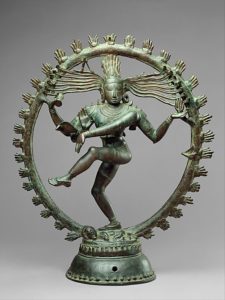
Lord of the Dance
Metropolitan Museum of Art
It is said that Nataraja (the Hindu god Shiva in his form as the cosmic dancer) dances the universe into being, sustains it with his rhythm, and eventually dances it into annihilation.
When Patanjali, the compiler of yoga’s foundational text, learned to dance, he noticed that the movements could be used to understand the body’s functions. His observations evolved into the classic sutras (aphorisms) of yoga.
Nataraja has great energy as he dances through five activities: creation, preservation, destruction or reabsorption, veiling reality, and illusion and grace. In his upper right hand Shiva holds an hourglass-shaped drum (Damaru) out of which emerges the rhythmic, primeval beat of the universe, and in his upper left-hand leaps a flame, symbolizing the dissolution of all creation. His open palm is in abhaymudra, the mudra (hand gesture) of reassurance, and his lower left arm reaches across his chest toward his raised left foot. This elegant movement is said to bestow grace and refuge. His right foot is balanced on the demon dwarf, Apasmara, a symbol of ignorance and delusion (maya). Surrounding him is a halo of flame—the vital force of nature arising from his energy, symbolizing that the destructive forces of the universe surround us at all times.
A central aim of yoga is to remove ignorance, or as St. Paul says, to remove the scales from our eyes. It is by seeing creation and destruction/illusion and grace clearly that we dance our Self into being. Just as Nataraja dances the universe into being, surrounded by the forces of nature, we must live our lives knowing that everything changes and there is no predicting what nature will bring.
Asana Natarajasana: Try this pose when you need a break from sitting at work.
See if you can assume this Lord of the Dance pose, or Natarajasana, and feel the presence of each aspect of life: creativity, grace, victory over ignorance, and refuge. Balance on your right foot, slightly bending your knee, and imagine triumph over ignorance, knowing yourself deeply in this moment. As you raise your left leg and foot toward your chest, gently bend your knee, crossing it over your right knee or shin. Raise your right hand in abhaymudra with your palm open, and feel reassured. Then, as gracefully as you can, raise your left hand to the height of your shoulder, palm open to the sky, and sense the power of the universe. If you are new to balancing poses, use the back of a chair or wall for the lower body posture, with just one arm raised.
If you sit for long periods of time, see if you can find a private place to do this pose. The standing balance will take pressure off your lumbar spine, and the muscles you use to hold the pose will increase your stamina when you return to your work. You may find that a new insight arises spontaneously after taking this short break.
- Psychotherapy in the Virtual Space: How teletherapy has changed the way we give and get care - April 26, 2021
- (home video area – couples counseling) - November 23, 2011
- (home video area – mindfulness) - November 23, 2011


Leave a Reply